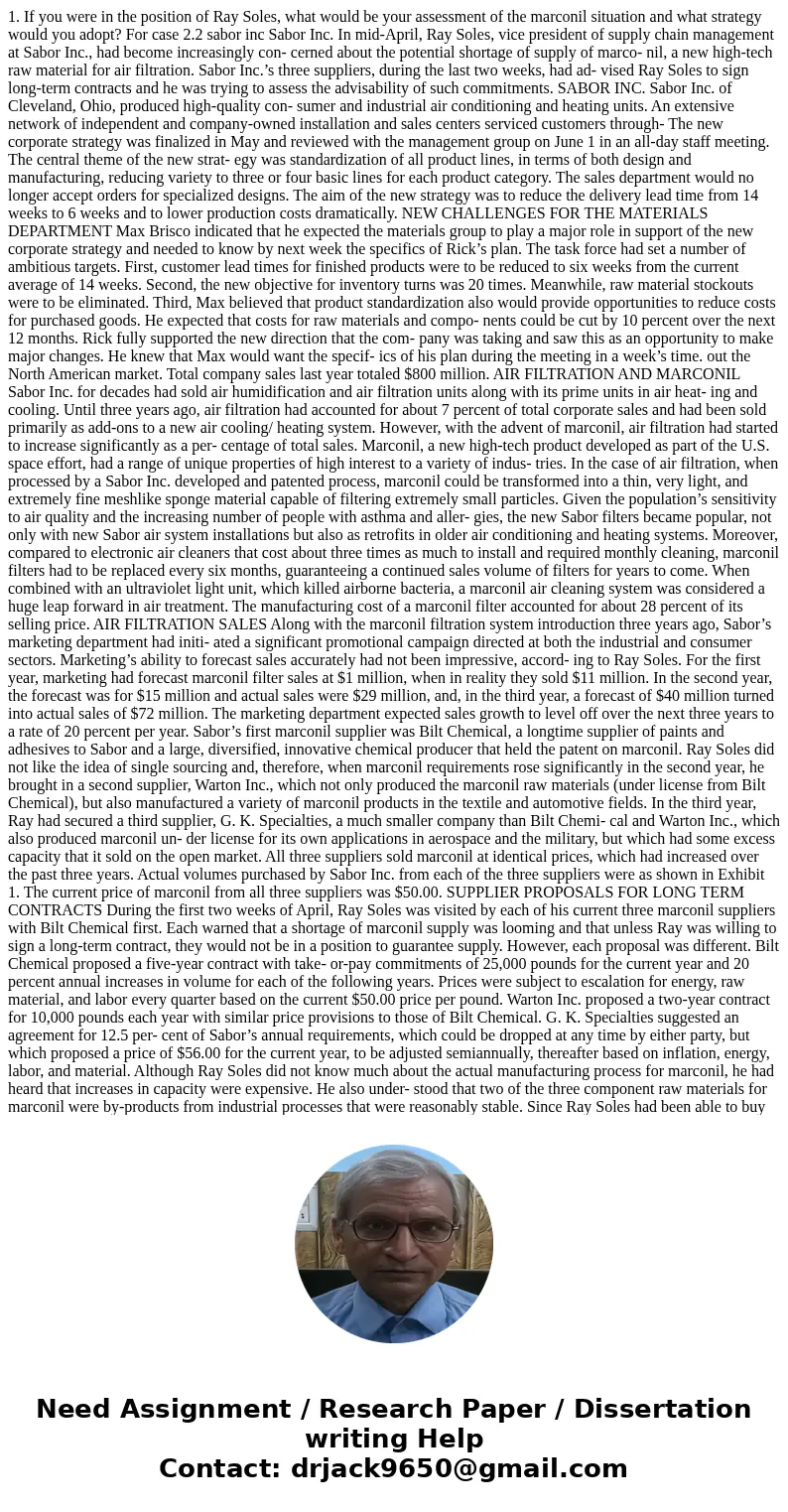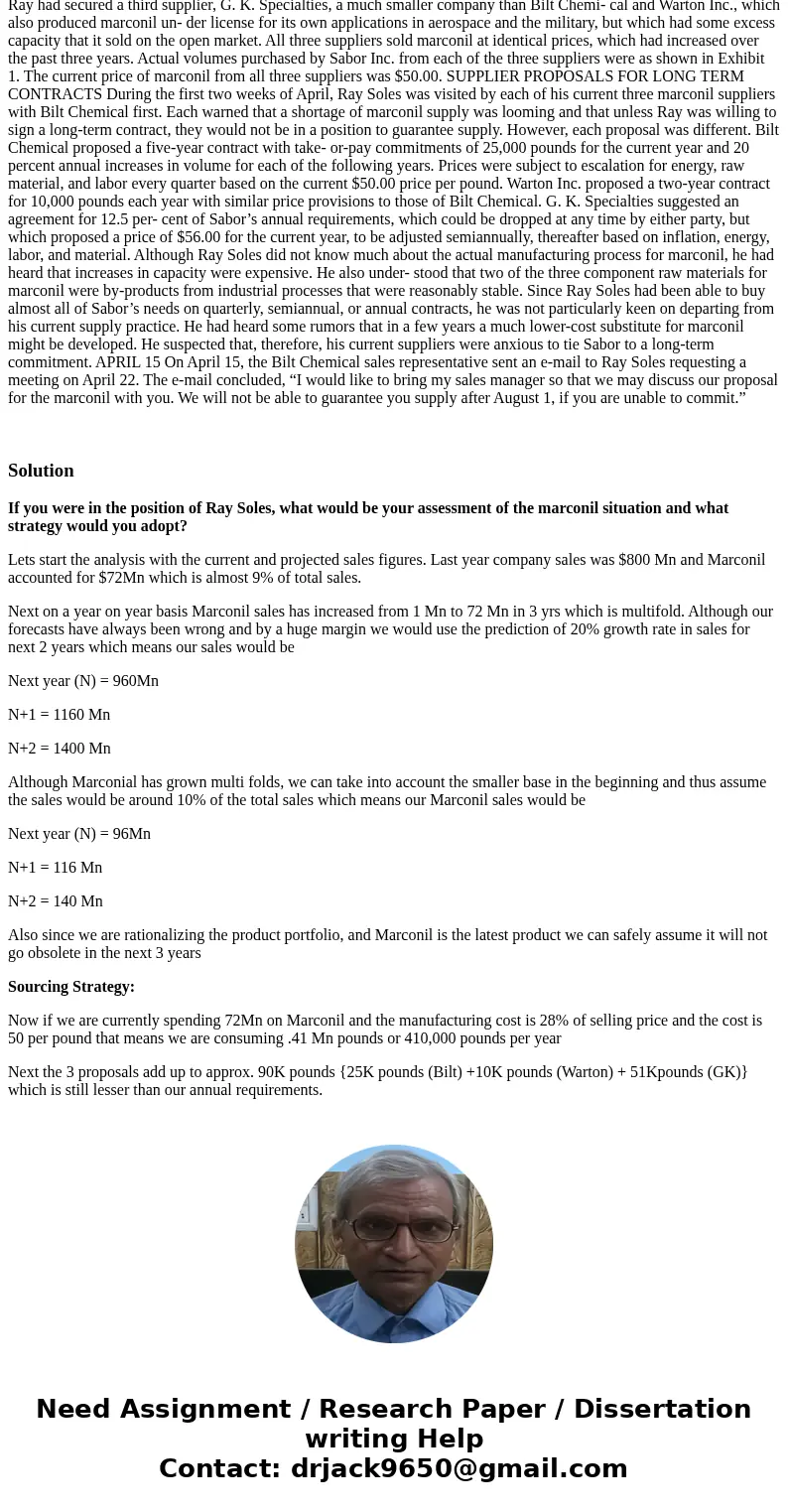1 If you were in the position of Ray Soles what would be you
1. If you were in the position of Ray Soles, what would be your assessment of the marconil situation and what strategy would you adopt? For case 2.2 sabor inc Sabor Inc. In mid-April, Ray Soles, vice president of supply chain management at Sabor Inc., had become increasingly con- cerned about the potential shortage of supply of marco- nil, a new high-tech raw material for air filtration. Sabor Inc.’s three suppliers, during the last two weeks, had ad- vised Ray Soles to sign long-term contracts and he was trying to assess the advisability of such commitments. SABOR INC. Sabor Inc. of Cleveland, Ohio, produced high-quality con- sumer and industrial air conditioning and heating units. An extensive network of independent and company-owned installation and sales centers serviced customers through- The new corporate strategy was finalized in May and reviewed with the management group on June 1 in an all-day staff meeting. The central theme of the new strat- egy was standardization of all product lines, in terms of both design and manufacturing, reducing variety to three or four basic lines for each product category. The sales department would no longer accept orders for specialized designs. The aim of the new strategy was to reduce the delivery lead time from 14 weeks to 6 weeks and to lower production costs dramatically. NEW CHALLENGES FOR THE MATERIALS DEPARTMENT Max Brisco indicated that he expected the materials group to play a major role in support of the new corporate strategy and needed to know by next week the specifics of Rick’s plan. The task force had set a number of ambitious targets. First, customer lead times for finished products were to be reduced to six weeks from the current average of 14 weeks. Second, the new objective for inventory turns was 20 times. Meanwhile, raw material stockouts were to be eliminated. Third, Max believed that product standardization also would provide opportunities to reduce costs for purchased goods. He expected that costs for raw materials and compo- nents could be cut by 10 percent over the next 12 months. Rick fully supported the new direction that the com- pany was taking and saw this as an opportunity to make major changes. He knew that Max would want the specif- ics of his plan during the meeting in a week’s time. out the North American market. Total company sales last year totaled $800 million. AIR FILTRATION AND MARCONIL Sabor Inc. for decades had sold air humidification and air filtration units along with its prime units in air heat- ing and cooling. Until three years ago, air filtration had accounted for about 7 percent of total corporate sales and had been sold primarily as add-ons to a new air cooling/ heating system. However, with the advent of marconil, air filtration had started to increase significantly as a per- centage of total sales. Marconil, a new high-tech product developed as part of the U.S. space effort, had a range of unique properties of high interest to a variety of indus- tries. In the case of air filtration, when processed by a Sabor Inc. developed and patented process, marconil could be transformed into a thin, very light, and extremely fine meshlike sponge material capable of filtering extremely small particles. Given the population’s sensitivity to air quality and the increasing number of people with asthma and aller- gies, the new Sabor filters became popular, not only with new Sabor air system installations but also as retrofits in older air conditioning and heating systems. Moreover, compared to electronic air cleaners that cost about three times as much to install and required monthly cleaning, marconil filters had to be replaced every six months, guaranteeing a continued sales volume of filters for years to come. When combined with an ultraviolet light unit, which killed airborne bacteria, a marconil air cleaning system was considered a huge leap forward in air treatment. The manufacturing cost of a marconil filter accounted for about 28 percent of its selling price. AIR FILTRATION SALES Along with the marconil filtration system introduction three years ago, Sabor’s marketing department had initi- ated a significant promotional campaign directed at both the industrial and consumer sectors. Marketing’s ability to forecast sales accurately had not been impressive, accord- ing to Ray Soles. For the first year, marketing had forecast marconil filter sales at $1 million, when in reality they sold $11 million. In the second year, the forecast was for $15 million and actual sales were $29 million, and, in the third year, a forecast of $40 million turned into actual sales of $72 million. The marketing department expected sales growth to level off over the next three years to a rate of 20 percent per year. Sabor’s first marconil supplier was Bilt Chemical, a longtime supplier of paints and adhesives to Sabor and a large, diversified, innovative chemical producer that held the patent on marconil. Ray Soles did not like the idea of single sourcing and, therefore, when marconil requirements rose significantly in the second year, he brought in a second supplier, Warton Inc., which not only produced the marconil raw materials (under license from Bilt Chemical), but also manufactured a variety of marconil products in the textile and automotive fields. In the third year, Ray had secured a third supplier, G. K. Specialties, a much smaller company than Bilt Chemi- cal and Warton Inc., which also produced marconil un- der license for its own applications in aerospace and the military, but which had some excess capacity that it sold on the open market. All three suppliers sold marconil at identical prices, which had increased over the past three years. Actual volumes purchased by Sabor Inc. from each of the three suppliers were as shown in Exhibit 1. The current price of marconil from all three suppliers was $50.00. SUPPLIER PROPOSALS FOR LONG TERM CONTRACTS During the first two weeks of April, Ray Soles was visited by each of his current three marconil suppliers with Bilt Chemical first. Each warned that a shortage of marconil supply was looming and that unless Ray was willing to sign a long-term contract, they would not be in a position to guarantee supply. However, each proposal was different. Bilt Chemical proposed a five-year contract with take- or-pay commitments of 25,000 pounds for the current year and 20 percent annual increases in volume for each of the following years. Prices were subject to escalation for energy, raw material, and labor every quarter based on the current $50.00 price per pound. Warton Inc. proposed a two-year contract for 10,000 pounds each year with similar price provisions to those of Bilt Chemical. G. K. Specialties suggested an agreement for 12.5 per- cent of Sabor’s annual requirements, which could be dropped at any time by either party, but which proposed a price of $56.00 for the current year, to be adjusted semiannually, thereafter based on inflation, energy, labor, and material. Although Ray Soles did not know much about the actual manufacturing process for marconil, he had heard that increases in capacity were expensive. He also under- stood that two of the three component raw materials for marconil were by-products from industrial processes that were reasonably stable. Since Ray Soles had been able to buy almost all of Sabor’s needs on quarterly, semiannual, or annual contracts, he was not particularly keen on departing from his current supply practice. He had heard some rumors that in a few years a much lower-cost substitute for marconil might be developed. He suspected that, therefore, his current suppliers were anxious to tie Sabor to a long-term commitment. APRIL 15 On April 15, the Bilt Chemical sales representative sent an e-mail to Ray Soles requesting a meeting on April 22. The e-mail concluded, “I would like to bring my sales manager so that we may discuss our proposal for the marconil with you. We will not be able to guarantee you supply after August 1, if you are unable to commit.”
Solution
If you were in the position of Ray Soles, what would be your assessment of the marconil situation and what strategy would you adopt?
Lets start the analysis with the current and projected sales figures. Last year company sales was $800 Mn and Marconil accounted for $72Mn which is almost 9% of total sales.
Next on a year on year basis Marconil sales has increased from 1 Mn to 72 Mn in 3 yrs which is multifold. Although our forecasts have always been wrong and by a huge margin we would use the prediction of 20% growth rate in sales for next 2 years which means our sales would be
Next year (N) = 960Mn
N+1 = 1160 Mn
N+2 = 1400 Mn
Although Marconial has grown multi folds, we can take into account the smaller base in the beginning and thus assume the sales would be around 10% of the total sales which means our Marconil sales would be
Next year (N) = 96Mn
N+1 = 116 Mn
N+2 = 140 Mn
Also since we are rationalizing the product portfolio, and Marconil is the latest product we can safely assume it will not go obsolete in the next 3 years
Sourcing Strategy:
Now if we are currently spending 72Mn on Marconil and the manufacturing cost is 28% of selling price and the cost is 50 per pound that means we are consuming .41 Mn pounds or 410,000 pounds per year
Next the 3 proposals add up to approx. 90K pounds {25K pounds (Bilt) +10K pounds (Warton) + 51Kpounds (GK)} which is still lesser than our annual requirements.


 Homework Sourse
Homework Sourse